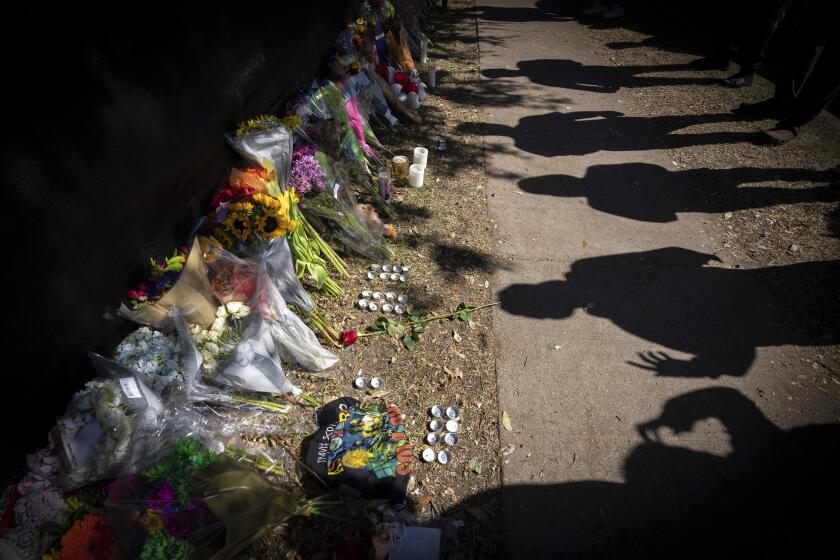Telling Israel’s Secrets : FIRST...
Almost invariably, open wars and negotiations between hostile states are punctuated by a “gray” substratum of covert activity--special operations, espionage and secret contacts. The Middle East conflict is no exception.
Shlomo Nakdimon and Steve Posner have set out to lift the veil and reveal a little of what has gone on behind the scenes since 1967 in what is arguably the world’s most troubled and explosive region.
Nakdimon, a veteran Israeli journalist, zeroes in on one major special operation--the Israel Air Force destruction on June 7, 1981, of the Iraqi nuclear reactor at al Tuweitha, outside Baghdad. He reviews the history of Iraq’s acquisition of the Osiris (renamed Osirak or Tammuz) reactor from France; the protracted, abortive Israeli diplomatic struggle against the deal; the decision-making processes that led to the dispatch of the eight F-16s and six F-15s that turned the reactor into dust; and the diplomatic aftermath, in which Jerusalem battled successfully, mainly in Washington, to avert major negative political fallout in the wake of the bombing.
Posner takes the broader canvas, looking successively at Israeli espionage and diplomacy in Lebanon during the 1970s and “its impact on the Israeli-Egyptian peace process”; at secret Israeli-Jordanian contacts and diplomacy between 1967 and 1987, and at American and Israeli maneuvering in Lebanon in the runup to the 1982 Israel Defense Forces (IDF) invasion.
The bombing of the reactor--which was universally admired for its daring and accuracy in planning and execution--at the time sparked a major debate within Israel, as well as a rather bitter if brief spat with the United States.
The strike was opposed by the heads of Israel’s two main intelligence bodies, the IDF Intelligence Branch and the Mossad, and by the opposition Labor Party. It was argued in Israel and, subsequently, by the United States that there was no certainty that the Iraqis had nuclear weapons in mind when purchasing and constructing the reactor complex and that, in any case, the Iraqis were still years away from a bomb-producing capability, if indeed that was their objective. Bombing the reactor, it was feared, would invite universal condemnation, Arab retaliation and a rift with the United States, and could torpedo the ongoing Israeli-Egyptian peace process. Lastly, it was argued, bombing Arab nuclear reactors would not solve the long-term threat posed by the coupling of Arab enmity with nuclear bomb-making capabilities--only peace could do that.
Prime Minister Menachem Begin, however, thought and gambled otherwise. Throughout, Begin had in his mind’s eye--and Nakdimon drives this point home persuasively--the memory of the 6 million Jews, who included his father and mother and 1.5 million children, slaughtered in the Holocaust in Europe. The strike on al Tuweitha was designed, as Begin wrote to “Dear Ron,” to prevent “a new Holocaust.” And Begin cogently argued that if Israel delayed, the reactor would go “hot” and an air strike then would unleash a lethal radioactive cloud over the Iraqi capital, killing thousands. (As it was, seven or eight Iraqis and one Frenchman died in the raid.)
Nakdimon makes no effort to hide his own views. He devotes long pages to describing Iraq’s then and current dictator, Saddam Hussein, as a mad dog (“the butcher of Baghdad,” “a murderous octopus”) who would stop at nothing to destroy Israel and who was hellbent on acquiring nuclear weapons for this purpose. Nakdimon’s condemnation of France’s leaders for uncaringly selling the nuclear bomb-making capability to Saddam is only slightly less vehement.
The author devotes no space at all to discussing the profound political, military and perhaps also ethical question of Israel’s own nuclear arsenal, a matter currently highlighted in the Vanunu trial in Jerusalem. The matter comes up only in passing when Nakdimon explains that the Arabs justify their drive to acquire such weapons on the grounds that Israel already possesses them.
Nakdimon, who was Begin’s press secretary during 1978-80, rather contemptuously dismisses Labor’s charge at the time that the air strike, which took place a bare month before the July 1981 Israeli general elections, was primarily an electioneering gimmick. The author throughout signals his admiration for the prime minister (who exactly one year later was to lead Israel into the Lebanese quagmire).
Nakdimon obviously had access to the minutes of cabinet and other policy-making meetings, from which he quotes or paraphrases liberally (and these are the most interesting passages in the book). But there are no references, so a great deal must be taken on trust.
Readers will be disappointed if they expect to find in the book revelations about the actual two-minute air strike that is its core. Nakdimon failed to discover, or at least get past the IDF censor, any fresh material about the preparatory intelligence-gathering, the flight of the F-16s and F-15s, their refueling, their avoidance of enemy radar and of Iraqi anti-aircraft fire, etc.
Worse still, he devotes only half a page to Israel’s first attempt against the reactor--when (Mossad?) bombs on April 6, 1979, blew up the core as it was awaiting shipment to Iraq in a Marseille warehouse--and only a few paragraphs to the obscure murder the following year in a Paris hotel room of Dr. Yahya al Meshad, a leading member of the Iraqi nuclear team. The treatment of both episodes is thoroughly inadequate. On the other hand, there is far too much detail about the countless diplomatic contacts and exchanges before and after the bombing.
Moreover, the writing is heavily padded and often loose (“Cabinet Secretary Arye Naor, who was privy to every state secret, whether military or political . . . “--really?) and the translation, while usually workmanlike, is often literal to the point of absurdity. Kidron, the translator, quaintly, if annoyingly, seems enamored of such archaisms as thereof.
Posner’s “Israel Undercover” is a different kettle of fish (or can of worms) altogether. If Nakdimon’s focus is narrow and intensive, Posner’s book tends toward an unattainable comprehensiveness.
There is practically nothing that has happened in the Middle East during the past two decades that Posner hasn’t crammed into this book--Lebanon’s civil war; Israeli, American and PLO diplomacy; Israeli-Jordanian relations; Egyptian fundamentalism; the Sadat assassination; Egyptian-Libyan relations; even the 1915 MacMahon letters and the 1916 Sykes-Picot Agreement. There are potted biographies of Begin, Sadat (a pro-Nazi “spy”), George Habash, King Hussein, Rafael Eytan--you name them, they’re in here, punching away at someone or other.
I was almost put off completely by the opening nine-page chapter, an irrelevant overture that catalogues recent Middle East massacres (Deir Yassin, Damour, Karantina, Sabra and Shatilla, Hama) in order to show that the Middle East is a nasty place and that Middle Easterners, by and large, are a nasty lot. So, what else is new?
Perhaps Posner’s aim is merely to catch and hold the reader’s attention. Whatever the case, the author then abruptly frog-marches us into the book’s best and most original 70 pages, which deal with the exploits of a Jordanian-Circassian woman named Dina al Aslan, who spied for the Mossad in Beirut during 1973-75. According to Posner, who interviewed the Amman-born Aslan’s relatives and friends in Jordan and the United States, the woman was then captured, tortured and jailed by the PLO for five years before being exchanged in Cyprus in 1980 for two PLO officers in Israeli hands.
The story, which has the ring of truth, makes riveting reading. Posner has Aslan baby-sitting for one of Black September’s leaders, then supplying her controllers with high-grade intelligence on PLO operations. Her tips, says Posner, triggered a series of Israeli raids on terrorist bases and the August 1973 aerial interception and hijacking of Middle East Airways Flight E006 on its way from Beirut to Baghdad (on suspicion that the plane was carrying Habash, head of the Marxist Popular Front for the Liberation of Palestine).
It was a thread provided by Aslan, according to Posner, that led Mossad agents to track down a British mercenary named “Brad Kirkland” who led his captors to a 1977 Kadafi plot to kill Sadat. On Begin’s instructions, the Mossad warned the Egyptian president and the plot was foiled.
Posner unpersuasively argues that Aslan’s reports thus “helped to launch the hidden diplomacy that culminated in Anwar Sadat’s dramatic visit to Jerusalem” in November, 1977.
Posner’s subsequent review of the secret meetings between King Hussein and various Israeli leaders--Yigal Allon, Yitzhak Rabin and Shimon Peres--during the past 2 1/2 decades is useful and enlightening. He has done a good job of collation and interpretation, illuminating those sad and ultimately fruitless bouts of negotiation.
Posner also gives us a good chapter on American-PLO contacts, tracing their history from the Kissinger ban of 1975 until Bob Ames’ negotiations in Beirut and the collapse of the CIA networks during the 1982 Israeli invasion. Ironically, Ames, a CIA man, died in the 1983 terrorist bombing of the U.S. Embassy in Beirut.
While sometimes riveting and insightful, “Israel Undercover” is marred by its overextended canvas and by conspiracy-theory assumptions which tend to throw in question the accuracy and credibility of the solid facts and judgments on offer.
More to Read
Start your day right
Sign up for Essential California for news, features and recommendations from the L.A. Times and beyond in your inbox six days a week.
You may occasionally receive promotional content from the Los Angeles Times.





